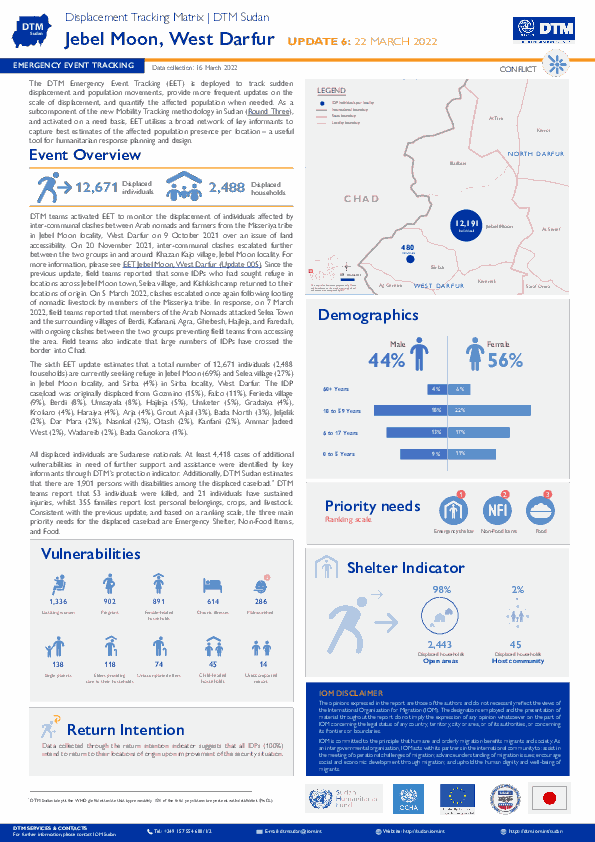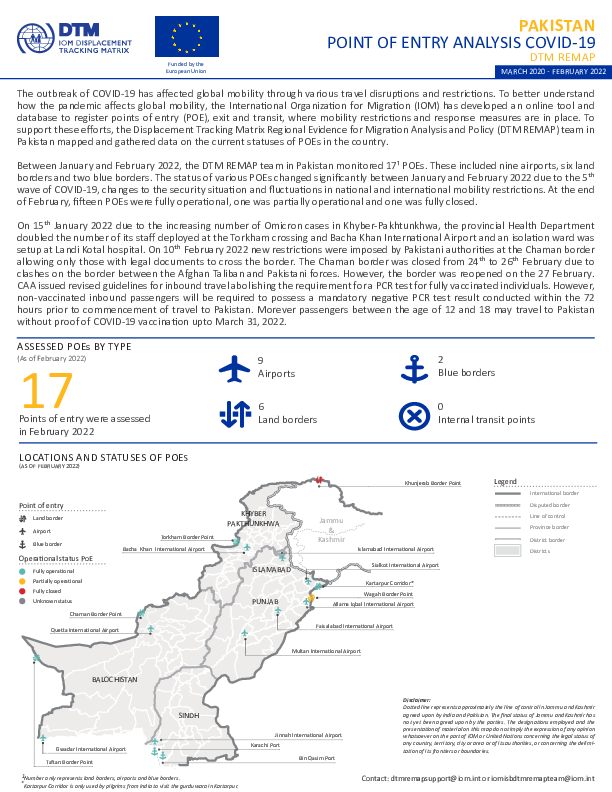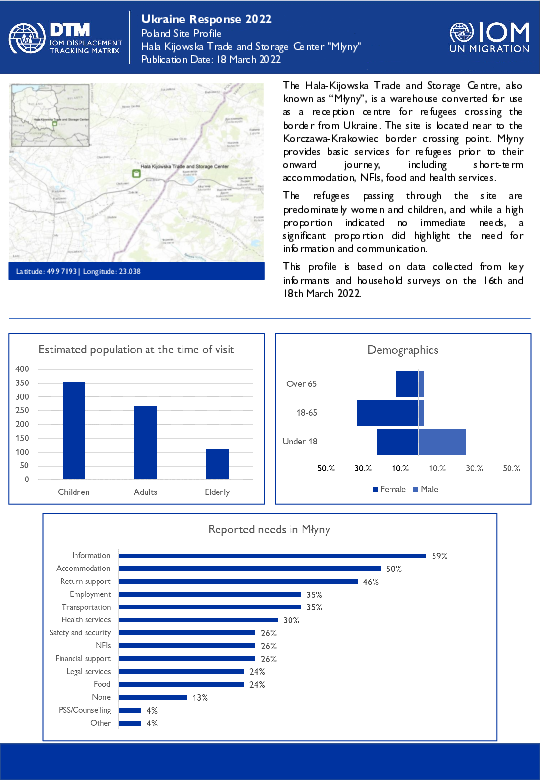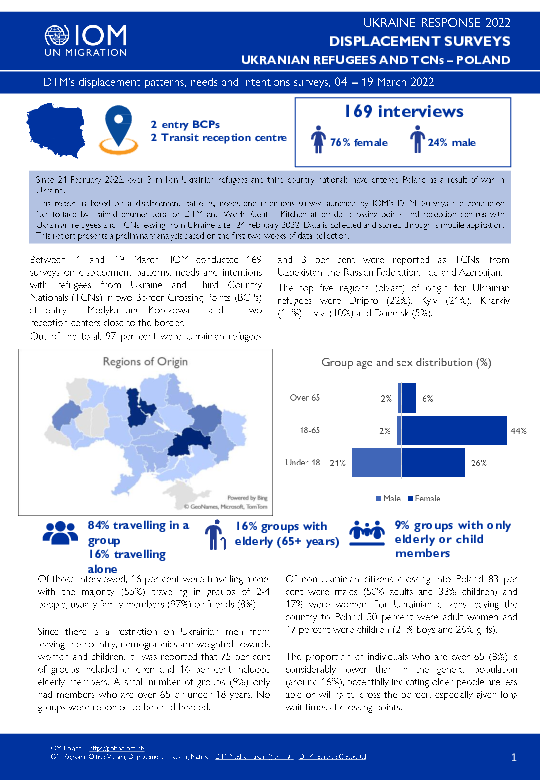-
Countries
-
Data and Analysis
-
Special Focus
-
Crisis Responses

Contact
DTM Djibouti, DTMDjibouti@iom.int
Language
English
Location
Djibouti
Period Covered
Feb 01 2022
Feb 28 2022
Activity
- Survey
- Flow Monitoring Survey
- Flow Monitoring
- Migrants presence
In February 2022, 15,242 movements were observed at the Flow Monitoring Points (FMPs) in Djibouti, representing a daily average of 544 movements. Migration flows increased by 20 per cent compared to the month of January 2022, during which an average of 454 movements had been registered daily. It is worth highlighting that migration flows have not yet reached pre-COVID-19 levels (between March 2019 and March 2020, the daily average was 621).

Contact
DTM Support, DTMSupport@iom.int
Language
English
Location
Mozambique
Period Covered
Mar 19 2022
Mar 22 2022
Activity
- Other
IOM MOZAMBIQUE Temporary Accommodation Centre Mapping|Tropical Cyclone Gombe & Heavy Rainfall – Nampula, Zambezia, Niassa and Sofala Provinces, March 2022

Contact
DTMUkraine@iom.int
Language
English
Location
Ukraine
Period Covered
Mar 09 2022
Mar 16 2022
Activity
- Survey
Starting on 24 February 2022, a large scale armed conflict triggered an unprecedented humanitarian crisis across all regions of Ukraine. Between March 9 and 16, the International Organization for Migration (IOM) conducted a rapid representative assessment of the general population in Ukraine to gather initial insights into internal displacement and mobility flows, and to assess local needs. While Displacement Tracking Matrix tools are being established, this general population assessment will serve as a preliminary source to identify areas with high humanitarian needs and to inform the targeting of response aiming to assist the conflict-affected population. The geographical scope of the assessment covers the entire territory of Ukraine, all five macro-regions (West, East, North, Centre, South, and the city of Kyiv), with the exception of the Crimean peninsula. The probabilistic sample, representative at macro-region level, was constructed through a random‐digit‐dial (RDD) approach, and 2,000 respondents aged 18 and over were interviewed using the computer assisted telephone interviewing (CATI) method. Those currently outside Ukraine were not interviewed. Population estimates assume that children travel together with their adult guardians. The estimates rely on the UNFPA population data for Ukraine, agreed upon as the common population baseline by the humanitarian community.
This report is also available in Ukrainian.

Contact
DTM Libya, DTMLibya@iom.int
Language
English
Location
Libya
Period Covered
Mar 13 2022
Mar 19 2022
Activity
- Other
As part of the third phase of the Libyan national COVID-19 vaccination campaign led by the Libyan National Centre for Disease Control (NCDC), IOM conducted awareness raising sessions on COVID-19 vaccines with a total of 604 adult migrants (41 females and 563 males) in three locations, Ain Zara detention centre and community settings in two municipalities during the reporting period (13 - 19 Mar 2022).

Contact
DTM Sudan; dtmsudan@iom.int
Language
English
Location
Sudan
Snapshot Date
Mar 16 2022
Activity
- Event Tracking
- Mobility Tracking
The DTM Emergency Event Tracking (EET) is deployed to track sudden displacement and population movements, provide more frequent updates on the scale of displacement, and quantify the affected population when needed. As a subcomponent of the new Mobility Tracking methodology in Sudan (Round Three), and activated on a need basis, EET utilises a broad network of key informants to capture best estimates of the affected population presence per location – a useful tool for humanitarian response planning and design.

Contact
iomisbdtmremapteam@iom.int
Language
English
Location
Pakistan
Period Covered
Mar 01 2020
Feb 28 2022
Activity
- Points of Entry (PoE)
The outbreak of COVID-19 has affected global mobility through various travel disruptions and restrictions. To better understand how the pandemic affects global mobility, the International Organization for Migration (IOM) has developed an online tool and database to register points of entry (POE), exit and transit, where mobility restrictions and response measures are in place. To support these efforts, the Displacement Tracking Matrix Regional Evidence for Migration Analysis and Policy (DTM REMAP) team in Pakistan mapped and gathered data on the current statuses of POEs in the country.
Between January and February 2022, the DTM REMAP team in Pakistan monitored 17¹ POEs. These included nine airports, six land borders and two blue borders. The status of various POEs changed significantly between January and February 2022 due to the 5th wave of COVID-19, changes to the security situation and fluctuations in national and international mobility restrictions. At the end of February, fifteen POEs were fully operational, one was partially operational and one was fully closed.

Contact
jslowey@iom.int
Language
English
Location
Poland
Period Covered
Mar 16 2022
Mar 18 2022
Activity
- Survey
The Hala-Kijowska Trade and Storage Centre, also known as “Młyny”, is a warehouse converted for use as a reception centre for refugees crossing the border from Ukraine. The site is located near to the Korczawa-Krakowiec border crossing point. Młyny provides basic services for refugees prior to their onward journey, including short-term accommodation, NFIs, food and health services. The refugees passing through the site are predominately women and children, and while a high proportion indicated no immediate needs, a significant proportion did highlight the need for information and communication. This profile is based on data collected from key informants and household surveys on the 16th and 18th March 2022

Contact
DTM Europe, DTMMediterranean@iom.int
Language
English
Location
Poland
Period Covered
Mar 04 2022
Mar 19 2022
Activity
- Survey
- Flow Monitoring
Since 24 February 2022, over 3 million Ukrainian refugees and third country nationals have entered Poland as a result of war in
Ukraine. This report is based on displacement patterns, needs and intentions survey launched by IOM's DTM. Surveys are conducted face-to-face by trained enumerators for DTM and World Central Kitchen at border crossing points and reception centres with Ukrainian refugees and TCNs leaving from Ukraine after 24 February 2022. Data is collected and stored through a mobile application. This report presents a preliminary analysis based on the first two weeks of data collection.

Contact
NMS Ukraine, nmsukraine@iom.int
Language
English
Location
Ukraine
Period Covered
Mar 09 2022
Mar 16 2022
Activity
- Mobility Tracking
- Baseline Assessment
On 11 March, the Protection Cluster released the first estimation of internally displaced persons (IDPs) in Ukraine since the military offensive started on 24th February. Estimates were based on a provisional methodology developed in consultation with OCHA, IOM, UNHCR and REACH. In the absence of credible sources of IDP data at that moment, and while the Government’s centralized registration system was not being applied, the Cluster stepped in to ensure that the preliminary estimated scale of internal displacement in Ukraine was brought to the attention of the international community.

Contact
DTM Nigeria, AllUsersInDTMNigeria@iom.int
Language
English
Location
Nigeria
Period Covered
Nov 16 2021
Dec 30 2021
Activity
- Mobility Tracking
- Baseline Assessment
This report, which presents the results from Round 40 of Displacement Tracking Matrix (DTM) assessments carried out by the International Organization for Migration (IOM), aims to improve the understanding of the scope of internal displacement, the plight of returnees and the needs of the displacement affected populations in north-east Nigeria. The report covers the period from 16 November to 30 December 2021 and reflects the trends from the six states in Nigeria’s north-east geopolitical zone. This zone is the most affected by the conflict and consists of the following states: Adamawa, Bauchi, Borno, Gombe, Taraba and Yobe. In Round 40, a total of 2,171,652 Internally Displaced Persons (IDPs) were identified in 446,740 households. This signifies a decrease of 1.3 per cent (or 28,705 individuals) compared to Round 39 when 2,200,357 IDPs were recorded (November 2021). The number of IDPs recorded during Round 40 also decreased by 10,961 individuals or less than 1 per cent compared to Round 38 when 2,182,613 IDPs were identified (August 2021). When comparing the number of IDP individuals between Round 40 and Round 36 (February 2021), the number of IDPs in north-east Nigeria has decreased by almost one per cent or 12,602 individuals during the past year.
Furthermore, 1,960,558 returnees were recorded in Round 40 assessments. This number represents an increase of 17,113
individuals or almost one per cent compared to Round 39 when 1,943,445 returnees were recorded (November 2021).
During Round 40, IDP assessments were conducted in 2,371 locations (down from 2,381 locations in Round 39). This report includes analyses of the number of returnees, their displacement profiles, shelter conditions, health, education,
livelihood, market, assistance and WASH facilities available to the returnees. Notably, as Borno is the most displacement-affected state in north-east Nigeria, it concentrates explicitly on the related data and analysis.
